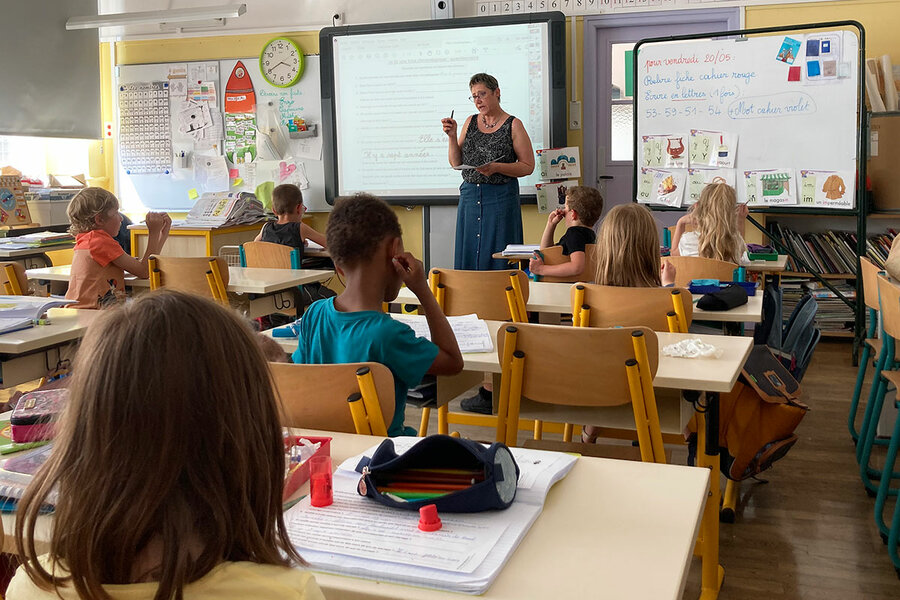European educators support Ukrainian students with flexibility – and empathy
Loading...
| Épernay, France; and Puerto de la Cruz, Canary Islands
Since the war began in their country on Feb. 24, more than 6 million Ukrainians have fled to neighboring countries. Half are estimated to be children.
Educators across Europe are trying to help young students cope. Utilizing government-led initiatives – and sometimes their own personal investments – teachers are working to foster a safe, welcoming space to Ukrainian children to recreate a sense of normal life and a semblance of home.
Why We Wrote This
Displaced Ukrainian children are resuming school routines in host countries across Europe. What are educators learning about the best way to support them?
Poland’s education ministry is working to integrate the more than 700,000 Ukrainian children who have arrived there in recent weeks. In France, more than 17,600 Ukrainian children are attending schools across the country.
Utilizing translation apps and other tools, educators are helping students focus on learning – and sometimes more basic needs. A school in the Spanish Canary Islands recently changed the bell that announced the end of class after one girl would grab her backpack and run every time it went off. It turned out it was the same sound as the bomb shelter siren in Ukraine.
“There needs to be empathy,” says Cécile Viénot, a child psychologist based in Paris. “The response can’t just be educational.”
It’s a hot and sticky day in Épernay, France. Amine jumps rope in a shady spot of the Chaude Ruelle elementary school building, laughing with his friends. With his carefree innocence, this 8-year-old appears no different from his classmates. But Amine barely escaped the bombs in March that crisscrossed his family’s hometown of Kharkiv, one of the hardest hit cities in Russia’s war in Ukraine.
Now, Amine is a typical second grader, learning math, science, and French, in an effort to make his temporary exile in France more bearable. He’s already starting to say a few words in his new language and has invited classmates home to play.
“He likes his teachers and his school. He’s very, very happy,” says Amine’s father, Adam, who was allowed to leave Ukraine as the father of five, soon to be six, children. Like other parents interviewed for this story, Adam asked to use first names only to protect his family. He is Chechen and has already fled his country once before. He says he’s grateful that his kids can enjoy the daily routine of classroom learning.
Why We Wrote This
Displaced Ukrainian children are resuming school routines in host countries across Europe. What are educators learning about the best way to support them?
“As parents, we’re very glad they can go to school, learn, and make friends. But I hope someday we can go back home.”
Since the war began in their country on Feb. 24, more than 6 million Ukrainians have fled to neighboring countries. Half are estimated to be children, some of whom are dealing with family loss and other trauma.
Educators across Europe are trying to help them cope. Utilizing government-led initiatives – and sometimes their own personal investments – teachers are working to foster a safe, welcoming space to Ukrainian children to recreate a sense of normal life and a semblance of home.
“School has the ability to absorb a child’s attention,” says Philip Jaffé, a Geneva-based psychotherapist and external consultant on children’s rights for the United Nations. “They go to class and have to be attentive to the teacher. Just being engaged in the learning process is very therapeutic in this context. Also, being surrounded by other children who scream, play, and fight creates a sense of normalcy that has a huge impact on kids.”
The support can be seen throughout Europe. Poland’s education ministry is working to integrate the more than 700,000 Ukrainian children who have arrived there in recent weeks, for example, and in Lithuania, the capital Vilnius has opened a free online school that can accommodate 80,000 Ukrainian refugee children in Poland, Romania, and Germany, among others. Currently about 1,000 children are enrolled.
“It’s part of our job”
In France, more than 17,600 Ukrainian children are attending schools across the country. Like other towns in France, Épernay, northeast of Paris, has been transformed into a welcome center for Ukraine’s refugees, with 430 children registered in the city’s school district of Reims.
The French Education Ministry has taken measures to make the transition easier – including, in coordination with the Ukrainian government, allowing students to follow Ukrainian curricula through a dedicated online platform. Schools also have access to a psychologist as well as tutors for learning French as a second language. But day to day, teachers are learning to adapt in their own ways.
Teachers at Chaude Ruelle use their classroom computers to teach Amine as well as fellow Ukrainians Damien and his sister Katerine things like French vowels and consonants. They’ve placed the students at the front of the classroom, often next to a child most likely to help, and downloaded teaching materials off the internet. When all else fails, teachers use their cell phones to upload translating apps to help with lessons.
“It creates a bit more work for us. We have to prepare more or translate things, but we’re happy to do this. It’s part of our job,” says Véronique Dumez, the principal of Chaude Ruelle and the kindergarten teacher of 7-year-old Katerine.
With just three Ukrainian students at her school of 120, Ms. Dumez has organized with fellow teachers in the district to share learning materials and hasn’t yet had to ask city hall for additional funding.
“There needs to be empathy”
Elsewhere, teachers in Tenerife, in the Spanish Canary Islands, are also considering the best ways to support their influx of students. There are over 350 Ukrainian children in schools across the eight Canary Islands, and 20 at the César Manrique elementary school in the beach town of Puerto de la Cruz. A neighboring pre-K and elementary school near the town church has 46.
Government funding for additional materials and educators in Tenerife has not always been easy to come by. Still, one school was recently able to help a student in a small way: It changed the bell that announced the end of class, after one girl would grab her backpack and run every time it went off. It turned out it was the same sound as the bomb shelter siren in Ukraine.
“Children generally have similar responses [to war] as adults, like symptoms of post-traumatic stress disorder,” says Cécile Viénot, a child psychologist based in Paris. “Right now, they’re in a phase of relief. They’re safe. Any anxiety they may feel is probably more due to adapting to their new surroundings.”
That is why it’s so important for teachers to be flexible and give new students ample time to adjust, while remaining faithful to the disciplined structure of a school day, says Ms. Viénot. “There needs to be empathy. The response can’t just be educational.”
Educators at the César Manrique school have tried to be aware of that balance. They recently held a meeting for Ukrainian parents to assess how they and their children are feeling about their school experience.
“They’ve all come at different times,” says Pablo Daryanani Medina, the English teacher at César Manrique, who has also acted as the go-between for Ukrainian families and the school, since many parents speak English more often than Spanish. “We never had the chance to ask them, ‘Do you need clothes or books? Are your kids happy?’”
Questions about geography – and war
At César Manrique, teachers have not explicitly explained why Ukrainian children have arrived en masse, preferring to address students’ questions as they come in hopes of “normalizing the situation,” says principal Candelaria Lorenzo Rodríguez.
For her colleague, Daryanani Medina, having new students who don’t speak Spanish has made his English classes more relatable for students. “It’s really enriching for me as a teacher but also for the kids,” he says. “They used to ask me why they need this information. Now they see it firsthand as a way of communicating.”
Back in France, teachers at the Chaude Ruelle school chose a more preemptive approach, explaining to students before the Ukrainian children arrived what they had lived through and asking them to be respectful to their new classmates.
“The kids asked us what happened in a war, where Ukraine was located. They were surprised by how close it was to France,” says Ms. Dumez. “It has allowed them to learn more about what’s happening in the news and has made them more interested in what’s going on around them.”
Ms. Dumez says the three Ukrainian students in her school have started to say a few words in French – like bonjour, merci, and au revoir – and play easily with the other kids during recess. Teachers aren’t testing them for the moment and say they’ll most likely pass them on to the next grade level next year to avoid the complications that come with holding students back.
Families are holding out hope that they can return to Ukraine in the next year or so. Every day after school at 4:30, Katerine and Damien sign on to Zoom to attend online classes back in Ukraine.
“They have to finish the Ukrainian school year, but it’s not necessarily with the idea of going back any time soon,” says Romain, Katerine and Damien’s father, who left Lviv with his wife and four kids at the beginning of March. “Who knows. There’s a strong possibility we’ll stay here. My wife is already saying maybe we should.
“The longer the kids are here and in school, making friends, the harder it will be to go back. Their grandfather is already telling me, ‘Make sure they don’t forget how to speak Ukrainian.’”









